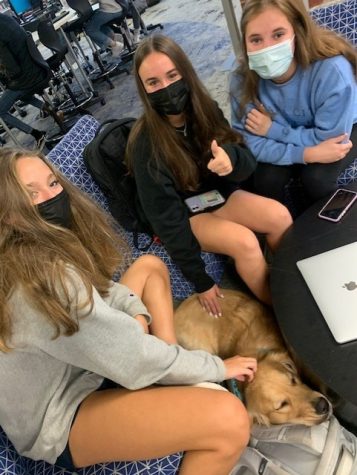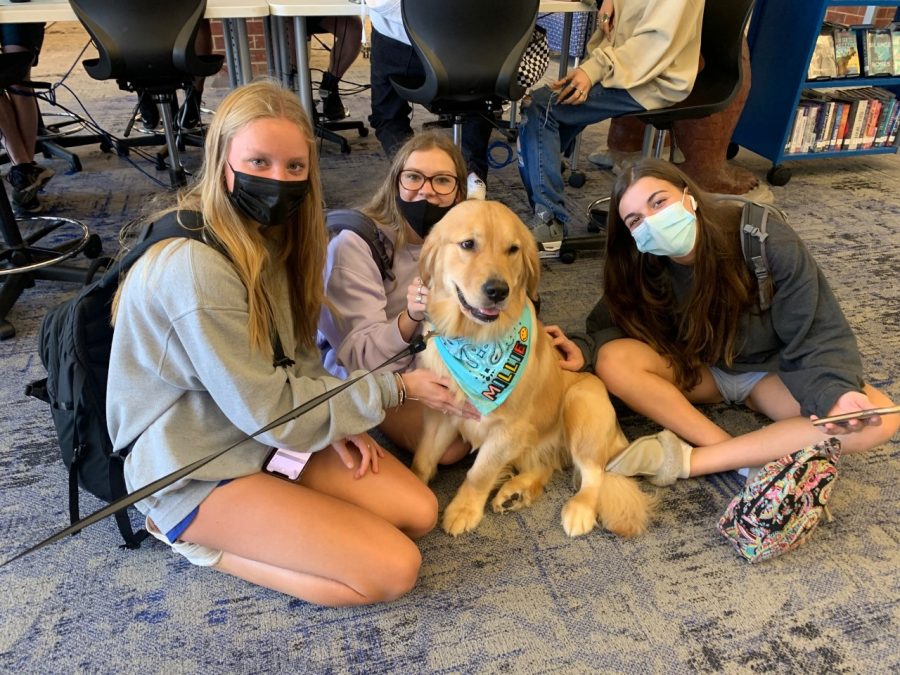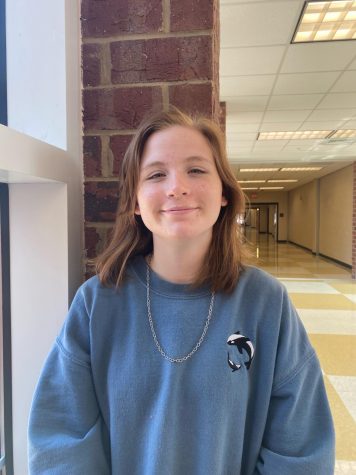Counseling Department Implements New Mental Health Programs
Students in the library hang out with Millie the golden retriever, who serves as the school’s therapy dog.
October 19, 2021
First day on the job. With her hair brushed and a light blue bandanna around her neck, she puts on her best smile. She’d been training for this moment for six months, and though the nerves could’ve gotten to her, she strode into the building with her head held pridefully high — and her tail held higher.
Who is the ‘she’ in question? It’s Millie, a golden retriever.
Millie is a therapy dog participating in Wellness Wednesdays, a collaboration between the Student Center and the counseling department to bring paws and ‘awws’ to the school. To find the fluffy dog, students simply have to walk into the Student Center and look for the dense crowd of students surrounding her.
Millie’s mom is a familiar face around the school: counselor Virginia White. White said Sept. 22nd, the day she first came to the Student Center, was her first day as a Cambridge therapy dog to see how she’d interact with students.
“She’s doing great,” she said, going on to say that Millie had fallen asleep surrounded by kids all day.

Wellness Wednesdays are being held every Wednesday.
Alongside Wellness Wednesdays, White has been organizing a small celebration to destigmatize mental health. The date is yet to be determined.
Stationed in the courtyard during all lunch periods, she’s hoping to have a variety of activities to inform students on mental wellness while still having a fun time. Counselors will cycle in and out, but White and Bianca Sheridan, a social worker, will be staying in the area the entire time.
A backdrop for photo-taking will be at the event, allowing students to take mental health awareness to social media. For the interactive element of the celebration, students will write positive affirmations on sticky notes and attach them to the backdrop. Sidewalk chalk also will be available.
Counselors will give out informational pamphlets and stickers, all with a QR code to connect students with a mental health professional.
The pamphlets will offer hotlines, resources and information regarding mental wellness. There also will be profiles on the counselors to “get to know your counselors in a fun way,” White said, adding that most students think counselors are only there to fix schedules, when they also offer mental help to students.
White hopes to hold a contest where the student wearing the most yellow will receive a prize. Yellow is an important color to suicide prevention: following the death of teenager Mike Emme in 1994, his family used the color yellow to pay tribute to him, and it’s something that remains to this day.
The Signs of Suicide (SOS) program the counselors are hoping to spearhead in homeroom is Nov. 9th during B².
The SOS program educates students on depression and how to handle it to decrease teen suicide rates and suicidal ideation.
One of these lessons is on the acronym ACT, which stands for acknowledge, care, tell. If students suspect they or a loved one is experiencing depression, they should acknowledge what they’re experiencing is serious, let their loved one know they care about them and tell a trusted adult they are concerned about themselves or a friend.
White said the counselors hope these events start conversations about mental health, and they urge students to start speaking up for themselves or others for whom they are concerned.
In the meantime, White said students can go to the Student Center to check out Millie “for all your therapy dog needs.”


Isabella Dudley-Flores • Oct 21, 2021 at 12:54 pm
what a great first story!! our fav fiction writer:)